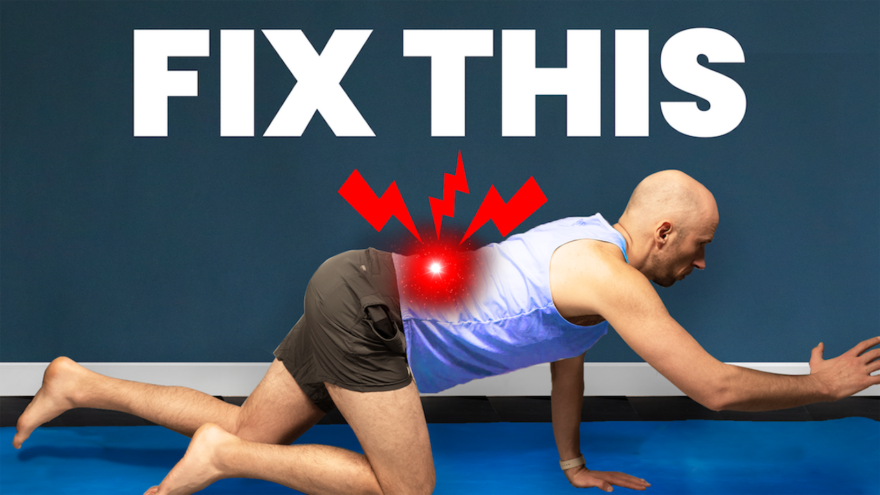Table of Contents
Building a Strong Core Without the Ache
Tired of wincing every time you tackle an ab workout?
You’re not alone. The good news is not all ab exercises have to hurt.
I’ve got a lineup of five exercises that’ll work your abs without triggering pain or flare-ups. Let’s dive into a world where ab workouts don’t have to hurt.
The Root Cause
There’s a common thing I see when ab exercises hurt.
That thing is poor relative motion between the torso and limbs.
Relative motion is independent movement between body segments. So I can move a limb in one direction while the torso moves in the apparent opposite direction.
When there is NOT relative motion, you’ll see the spine and limbs move together. Often it’s from a specific hinge point. In my experience, it’s most commonly the thoracolumbar junction.
The key? Learning to move your arms and legs independently of your spine WITHOUT bracing.
The Exercises
For these exercises, you’ll need a swiss ball. Ya know, one of those big exercise balls. They are pretty cheap.
If you don’t want to spend like nothing, then press your arms against the thighs. A foam roller can work too.
Sidelying Arm Lift
This move starts in a sidelying. I use this exercise for 2 reasons:
- Improve front-to-back ribcage dimensions
- Reduce pec major and rectus abdominis muscle activity. These puppies can contribute to spinal orientations.
Here’s how to do it:
- Lie on your side, head supported, feet together, legs slightly apart.
- Roll forward slightly to feel the bottom outside knee on the ground.
- Place the Swiss ball on your thighs, hands resting on it.
- Press down with your top leg and bottom arm (about 3-4/10 effort).
- Nasal inhale and lift your arm diagonally
- Mouth exhale and move arm back to the ball
Do 2-3 sets of 6-8 reps per side for 1-2 weeks.
Sidelying leg lift
Similar to the arm lift. But this time, you are moving the top leg.
- Lie on your side, head supported, feet together, legs slightly apart.
- Roll forward slightly to feel the bottom outside knee on the ground.
- Place the Swiss ball on your thighs, hands resting on it.
- Press down with your top leg and bottom arm (about 3-4/10 effort).
- Nasal inhale and lift your top leg off the ball
- Mouth exhale and move leg back to the ball
Do 2-3 sets of 6-8 reps per side for 1-2 weeks.
Swiss Ball Weight Shift
Now that you’ve mastered sidelying, we can move to supine. I like this weight-shift exercise. It teaches you to rotate the torso without it ONLY happening through those hinge points.
- Lie on your back, weight-bearing on four points: the PSIS and between the shoulder blades.
- Place the ball between your thighs and hands.
- Apply gentle pressure (3-4/10) to the ball.
- Mouth exhale and shift weight to one side
- Nose inhale and hold position
- Exhale and shift to the other side
Do 2-3 sets of 6-8 reps per side for a couple of weeks.
Dead Bug Progression
The first few moves set the stage for moving the legs. Now we will work on moving the limbs. I like a dead bug progression for this.
I’ll first move the arms and legs only.
Then I’ll put it all together.
Here are the keys:
- Find your four points and apply pressure to the ball.
- Start with arm movements: inhale and lift one arm diagonally, then exhale and return.
- Follow with leg movements: inhale and tap the ground with one foot, then exhale and return.
- Combine arm and leg movements once you’re comfortable.
Do 2-3 sets of 8-10 reps for a few weeks. You can either break these up into segments, then combine them. Or perform the individual turns first, then go.
Flutters
Ready to amp up the burn? Add a flutter motion to the dead bug.
- Lie on your back, find your four points, and apply pressure to the ball.
- Lift one arm and flutter it for time, then switch.
- Do the same with your legs, maintaining PSIS and upper back contact.
– Start with 2-3 sets of 10 seconds. Increase to 60 seconds over time.
Sum up
This progression will build your foundation to do WAY more ab exercises pain-free. Work through this progression and NO ONE will mess with you.
If you notice that you have other mobility restrictions, this follow along ought to help you out.

